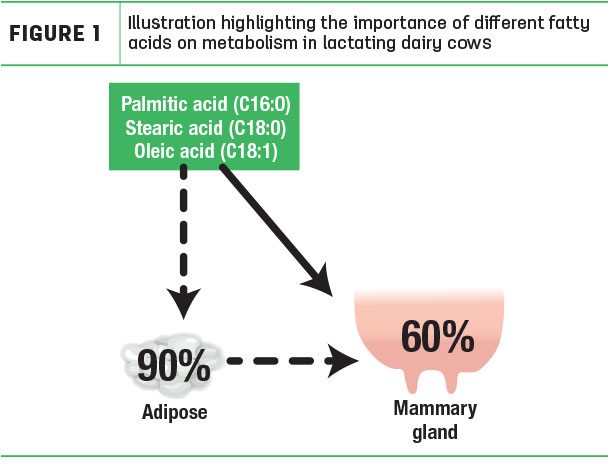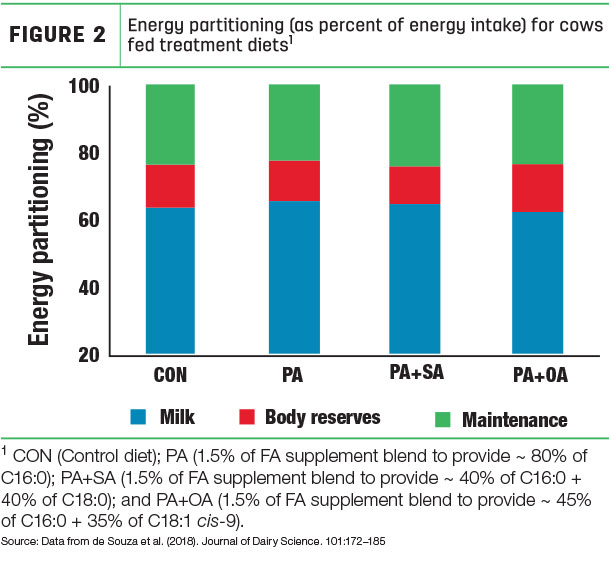The digestion and metabolism of dairy cow fats and fatty acids is of great significance to the dairy industry. This issue has regained attention for multiple reasons. First, adding supplemental fatty acids to the diet is a common practice in dairy cow nutrition to increase the energy concentration of the diet and support milk production. Secondly, we have now realized that fatty acids can have a special and effective effect on the digestion and metabolism of ruminants. Generally speaking, fatty acid supplementation has been shown to increase milk production, milk fat production and milk production efficiency. But different fatty acid supplements, and even the same fatty acid supplements, reported different production performances in different diets and studies.
There are a variety of fat supplements for lactating cows. Although these supplements may differ in the method of protection, particle size, and degree of esterification, the composition of fat supplements is most likely to be the main factor affecting the production response.
Recent research has focused on specific fatty acids and how cows respond differently to fatty acid combinations at different stages of lactation. Among them, dietary palmitic acid (C16: 0), stearic acid (C18: 0) and oleic acid (cis-9 C18: 1) have always been of concern because these fatty acids are present in a large number of commercially sold fat supplements Agents, and they account for a large proportion of milk fat and fat tissue in cows

Figure 1 Graphical illustration of the importance of different fatty acids for the metabolism of lactating dairy cows
Our recent research highlights the effect of changing the fatty acid composition of supplementary fat in dairy cow diets. By changing the fatty acid composition supplied in the supplement, we can observe differences in nutrient digestibility, milk production, milk fat production and body weight gain.
In a recent study, we compared the effects of different combinations of fatty acid supplementation C16: 0, C18: 0 and cis-9 C18: 1 (fed on 1.5% dry matter of the diet) on cows after lactation peak. When compared with other treatments, fat supplements containing more C16: 0 (80% C16: 0 and 10% cis-9 C18: 1) increased the response of milk production and milk fat production.
In contrast, fat supplements containing C16: 0 and cis-9 C18: 1 (45% C16: 0 and 35% cis-9 C18: 1) increased cows when compared to other treatments Weight and body condition. A fat supplement containing a combination of C16: 0 and C18: 0 (C16: 0 40%, C18: 0 40%) reduces the digestibility of nutrients, which most likely explains why it is reduced compared to other treatments Production response.
This may indicate that C16: 0 and Shun-9 C18: 1 can change the energy distribution for milk or body storage, so that different fatty acid supplements can be fed under specific circumstances according to the cow's metabolic priority and needs.

Fig. 2 Energy distribution of feeding diets for cows (expressed as a percentage of energy intake)
Note: CON (control diet); PA (mixture of fatty acids accounting for 1.5% of the diet, providing about 80% C16: 0); PA + SA (mixture of fatty acids accounting for 1.5% of the diet, providing about 40% C16: 0 and 40% of C18: 0); OA (mixture of 1.5% of fatty acids in the diet, providing about 45% of C16: 0 and 35% of C18: 1)
In a follow-up study, we changed the ratio of C16: 0 and cis-9 to C18: 1 in the fatty acid supplement, and fed them to two groups of cows according to the cow ’s production level after peak production. Fatty acid supplements with more C16: 0 (80% C16: 0 and 10% cis-9 C18: 1) increase milk yield, milk fat and milk protein in cows with a daily milk production of less than 45.4 kg Yield, and in cows with more than 59 kg of milk per day, supplementation with cis-9 C18: 1 (60% C16: 0 and 30% cis-9 C18: 1) is beneficial for milk production response.
Interestingly, regardless of the production level, more Shun-9 C18: 1 supplements increased body weight. These results emphasize that different fatty acid supplements or fatty acid combinations should be based on the production level of the herd or the specific herd.
For newly born cows, the high metabolic demand for lactation during the postpartum period leads to a negative energy balance. Regarding the benefits of fatty acid supplementation for dairy cows during early lactation, the effect is contradictory. We believe that this is caused by the difference in fatty acid composition of the supplements used and the timing of the start of fatty acid supplementation.
In a recent study, we evaluated the effect of C16: 0 supplementation time on the performance of early lactating cows. During the new birth period (1 to 24 days after calving), we did not observe differences in the treatment of feed intake, but compared with the control group, C16: 0 continued to increase the energy-corrected milk production by 4.99 kg / day.
However, compared with the control group, C16: 0 reduced the body weight by 20.8Kg. During the peak lactation period (25-67 days after calving), feeding C16: 0 increased milk production by 3.63 kg per day and energy-corrected milk at 4.99 kg / day. Compared with the control group, the weight tended to be reduced by 9.98kg. In a follow-up study of newly born cows, we changed the ratio of C16: 0 and cis-9 to C18: 0 in the fatty acid supplement of newly born cows (1 to 24 days after calving). Similar to our previous study, a recent study of feeding fatty acids supplemented with more C16: 0 (80% C16: 0 and 10% cis-9 C18: 1) increased milk production by 2.27 kg / day , Energy correction milk 4.99kg / day, when compared with the control group, tends to lose weight 14.98kg.
On the other hand, feeding a fatty acid supplement with more cis-9 C18: 1 (60% C16: 0 and 30% cis-9 C18: 1) increased milk production by 2.27kg / day, energy Corrected milk 4.54kg / day, but compared with the control group, did not affect body weight. These results indicate that newly born and early lactating cows respond well to supplemental fat, and the effect on body weight depends on the fatty acid composition supplemented.
In conclusion, our research emphasizes that it is the key to understand which fatty acids are present in the diet, especially the fats in the fat supplements. At the same time, palmitic acid and oleic acid are the key fatty acids to consider when choosing a fat for supplementation.
When choosing a fatty acid supplement, it is important to consider the feed intake of these fatty acids, rumen metabolism, intestinal digestibility, milk fat synthesis in the breast, energy distribution between the breast and other tissues, body condition and immunity And reproductive function. The extent of these changes at the same time will determine the overall effect of fatty acid supplementation and the related decision to add to the diet of lactating cows.




.jpg)
